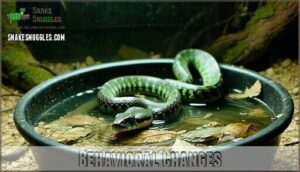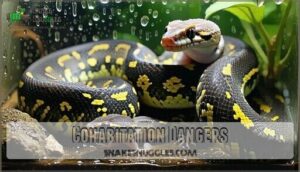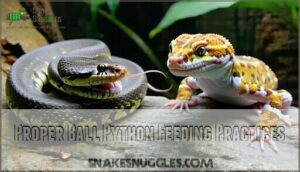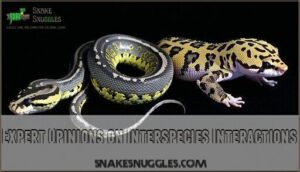This site is supported by our readers. We may earn a commission, at no cost to you, if you purchase through links.
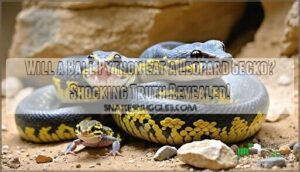
The short answer? It’s unlikely, but not impossible.
Ball pythons typically stick to rodents like mice and rats, which match their natural hunting instincts.
However, if your python gets hungry enough or the gecko’s size is tempting, it might give it a shot.
Think of it like a person eyeing a weird sandwich when they’re starving – desperation changes the menu.
The real issue isn’t whether a ball python will eat a leopard gecko, but whether you should risk finding out the hard way.
Table Of Contents
- Key Takeaways
- Natural Diet of Ball Pythons
- Leopard Gecko as Potential Prey
- Risks of Feeding Geckos to Ball Pythons
- Cohabitation Dangers
- Proper Ball Python Feeding Practices
- Leopard Gecko Care and Safety
- Ethical Considerations
- Legal Aspects of Reptile Ownership
- Expert Opinions on Interspecies Interactions
- Safe and Responsible Reptile Keeping
- Frequently Asked Questions (FAQs)
- Conclusion
Key Takeaways
- You shouldn’t risk housing them together – While ball pythons typically eat rodents, they’ll consider your leopard gecko a snack if hungry enough, creating a dangerous predator-prey situation that’s not worth gambling with your pets’ lives.
- They can’t share the same environment – Ball pythons need 50-60% humidity, while leopard geckos require only 30-40%, plus completely different temperature ranges, making cohabitation impossible without compromising both animals’ health.
- Feeding geckos to pythons creates serious problems – Leopard geckos don’t provide proper nutrition for ball pythons, can transmit parasites, and cause digestive issues, since pythons aren’t designed to process gecko-based diets.
- Stick to proper prey and separate housing – Keep your ball python fed with appropriately-sized frozen-thawed mice or rats, house both species in completely separate enclosures, and you’ll avoid stress, injuries, and potential veterinary emergencies.
Natural Diet of Ball Pythons
You’ll find that ball pythons are strict carnivores who’ve evolved to hunt small mammals like mice, rats, and occasionally birds in their native African grasslands.
Understanding what these snakes naturally eat helps you make informed decisions about whether they’d view your leopard gecko as dinner rather than a roommate.
Preferred Prey in The Wild
Most ball pythons in their natural habitat across West and Central Africa are opportunistic hunters with specific dietary preferences. Their natural instincts drive them to target small mammals through ambush predation.
Their wild diet typically includes:
- Small rodents like mice and rats
- Ground-dwelling birds and their eggs
- Juvenile mammals such as shrews
- Occasionally amphibians in wetland areas
- Young rabbits in suitable prey availability zones
This predator-prey relationship shapes their hunting strategies and dietary adaptations perfectly, making them efficient in their natural environment with their ambush predation tactics.
Captive Diet Recommendations
Moving from their wild hunting habits to home care, your ball python’s captive diet needs careful planning.
Frozen-thawed rodents should be your go-to choice – they’re safer than live prey and won’t fight back.
Think of it as ordering takeout instead of hunting for dinner!
Stick to mice and rats that match your snake’s girth.
Young pythons need weekly meals, while adults eat every two weeks – that’s your feeding schedule sorted.
Nutritional supplements aren’t usually necessary with whole prey.
For convenience, many owners purchase pre-killed feeder rodents.
Portion control matters too; oversized meals can cause serious health problems.
Always provide fresh water for hydration needs.
Skip the exotic prey like geckos – stick to proven reptile food options, and remember, frozen-thawed rodents are the best choice for a safe and healthy diet, with weekly meals for young pythons and every two weeks for adults, ensuring a well-planned captive diet.
Leopard Gecko as Potential Prey
You might wonder if your ball python could actually snack on your leopard gecko, and the answer isn’t as straightforward as you’d think.
Spoiler alert: your ball python sees your leopard gecko as a gourmet meal, not a roommate.
While ball pythons can physically consume leopard geckos due to their size compatibility, this combination creates serious nutritional and safety concerns that every reptile owner needs to understand.
Size Comparison
Understanding the dramatic size comparison between these reptiles reveals why predation becomes a real concern.
Your ball python typically reaches 3-5 feet in length, while leopard geckos max out at just 7-10 inches.
This creates a significant size difference that puts geckos at serious disadvantage.
Python girth matters too – adult ball pythons can weigh 3-5 pounds compared to a gecko’s mere 45-90 grams.
That’s like comparing a watermelon to a grape!
This size mismatch creates clear prey dimensions that spell trouble.
Consider these alarming gecko vulnerability factors:
- Ball pythons are 4-6 times longer than leopard geckos
- Weight difference exceeds 10-15 times between species
- Python gecko encounters favor the larger predator
- Gecko snake interactions pose serious ingestion risks
When predation instincts kick in, size absolutely matters.
Your python gecko size differential creates a natural predator-prey dynamic that’s impossible to ignore.
It’s important to keep in mind appropriate prey sizing to prevent health risks.
Nutritional Value
When you’re looking at the nutritional value of a leopard gecko as snake prey, you’ll quickly discover it’s like trying to fuel a sports car with cooking oil.
The Gecko Nutritional Profile simply doesn’t match your Python Nutrient Needs. Leopard geckos survive on insects like crickets and mealworms, creating a body composition that’s nutritionally unbalanced for python feeding.
This mismatch leads to serious Dietary Imbalances and Nutritional Deficiencies in your ball python. Think of it this way: your snake needs the equivalent of a complete meal, but a gecko offers more like an incomplete snack.
The leopard gecko diet of insects doesn’t provide the fat-to-protein ratio your python requires. Alternative Prey Value from appropriate rodents offers complete nutrition, while geckos leave your snake malnourished and potentially sick.
Risks of Feeding Geckos to Ball Pythons
You’re playing with fire if you consider feeding your leopard gecko to your ball python, as this risky practice can trigger serious health problems and dangerous behavioral shifts in your snake.
While it might seem like a natural solution, this feeding choice often leads to nutritional deficiencies, digestive issues, and aggressive changes that’ll make your python harder to handle and feed properly, resulting in serious health problems.
Potential Health Issues
While leopard geckos might seem like convenient prey, they’re basically poison wrapped in scales for your ball python.
You’re asking for trouble when you ignore your snake’s natural predator-prey relationship patterns.
Nutrient Deficiencies top the list of concerns.
Leopard geckos can’t provide the balanced nutrition your python needs, leading to malnutrition over time.
Their insect-based diet creates Digestive Problems since ball pythons aren’t equipped to process these foreign proteins properly.
Parasite Transmission becomes a serious threat.
Wild-caught geckos often carry parasites that’ll wreak havoc on your python’s system.
You’ll notice Stress Indicators like refusing food, excessive hiding, or aggressive behavior when predation potential increases.
Dehydration Risks spike because geckos have different water content than typical prey.
This messes with your snake’s hydration balance, causing further health risks and digestion issues.
- Cross-contamination from shared enclosures amplifies every health concern mentioned above
Smart keepers stick to appropriate frozen-thawed rodents instead.
Behavioral Changes
Physical health problems aren’t the only concern when ball pythons encounter leopard geckos. Your snake’s behavior can shift dramatically, creating new challenges you didn’t expect. The predator-prey dynamic triggers complex responses that affect your pet’s daily routine and temperament.
These behavioral changes stem from your ball python’s natural hunting instincts becoming confused or overstimulated. The leopard gecko’s size and movement patterns can create lasting impressions that disrupt normal feeding schedules and handling routines.
| Behavioral Change | Severity | Signs to Watch |
|---|---|---|
| Feeding Refusal | High | Skipping regular meals |
| Stress Indicators | Moderate | Hiding, defensive posing |
| Hunting Instincts | Variable | Increased stalking behavior |
| Activity Changes | Low | Reduced movement patterns |
| Aggression Levels | High | Striking at handling attempts |
It’s essential to understand ball python feeding habits to mitigate feeding refusal. The leopard gecko’s presence can have a significant impact on your ball python’s behavior, leading to stress indicators and changes in activity levels. By recognizing these signs, you can take steps to minimize the effects of this encounter and ensure your pet’s well-being.
Cohabitation Dangers
You can’t house ball pythons and leopard geckos together because they’ve completely different environmental needs that create a dangerous living situation.
Your ball python needs 50-60% humidity while your leopard gecko requires only 30-40%, and this mismatch leads to stress, illness, and potential predation between these species.
Environmental Incompatibility
Why would mixing a desert dweller with a humidity lover spell disaster? Environmental incompatibility between ball pythons and leopard geckos creates a recipe for reptile chaos.
These species evolved in vastly different habitats, making cohabitation nearly impossible without compromising someone’s health.
The fundamental habitat mismatch becomes obvious when you examine their needs:
- Temperature Gradients: Ball pythons thrive at 78-88°F, while leopard geckos prefer 75-90°F with distinct hot and cool zones
- Humidity Differences: Your python needs 50-60% humidity, but your gecko requires only 30-40% to prevent respiratory issues
- Enclosure Size: Ball pythons need larger, taller spaces while geckos prefer wider, ground-level territories
Forcing reptile compatibility between these species creates stress for both animals.
The predator-prey relationship adds another layer of complexity, as lighting needs also differ markedly. Your gecko requires UVB lighting for proper calcium absorption, while your python doesn’t need supplemental lighting.
This environmental incompatibility makes successful cohabitation virtually impossible.
Stress and Aggression
The predator-prey relationship between these species creates dangerous stress and aggression. Your ball python views the gecko as dinner, while your gecko lives in constant fear. This cohabitation risks disaster.
Enclosure Stressors trigger chronic anxiety in both animals. The python’s solitary nature means it doesn’t want roommates, especially prey-sized ones. Feeding Triggers activate when the python smells or sees the gecko moving. One major sign of stress is the ball python’s hissing.
| Stress Signs | Ball Python | Leopard Gecko |
|---|---|---|
| Behavioral Changes | Increased striking | Constant hiding |
| Physical symptoms | Refusing food | Weight loss |
| Activity patterns | Excessive roaming | Reduced movement |
| Health issues | Weakened immunity | Digestive problems |
| Long-term effects | Shortened lifespan | Chronic illness |
Handling Aggression and Reducing Stress requires separate housing immediately.
Proper Ball Python Feeding Practices
You’ll want to stick with appropriately-sized frozen-thawed rodents like mice or rats, since they provide the complete nutrition your ball python needs without the risks that come with unconventional prey.
Feeding your snake weekly as a juvenile or bi-weekly as an adult keeps them healthy and prevents the kind of feeding mistakes that turn curious pet owners into emergency vet visitors.
Appropriate Prey Items
When choosing appropriate prey for your ball python, think "natural menu" rather than exotic experiments.
Your snake’s ball python diet thrives on frozen-thawed mice and rats, which provide proper rodent nutrition without the frozen-thawed risks of improper handling.
While the live prey debate continues among keepers, frozen options eliminate injury risks from struggling prey.
A leopard gecko creates dangerous size difference complications and disrupts the natural predator-prey relationship.
Focus on prey variety within rodent species – from adult mice to small rats.
Consider supplementation needs only when recommended by your reptile veterinarian for specific health concerns.
To guarantee proper digestion, remember to maintain proper enclosure temperatures.
Feeding Frequency and Schedule
Your ball python’s feeding schedule isn’t rocket science, but getting it right makes all the difference. Juvenile feeding requires meals every 5-7 days since growing snakes need consistent nutrition.
Adult schedules shift to every 10-14 days – think of it like switching from teenager appetite to adult metabolism.
Adjusting frequency depends on your snake’s body condition and activity level. A chunky python might need longer breaks between meals, while an active one could handle slightly more frequent feeding.
Overfeeding risks include obesity and regurgitation, so resist the urge to spoil your scaly friend.
Prey digestion takes 3-5 days, during which your python shouldn’t be handled.
Remember, a proper ball python diet consists of appropriately-sized rodents – never a leopard gecko. The size difference and species incompatibility make geckos unsuitable prey regardless of feeding frequency.
Leopard Gecko Care and Safety
You’ll want to create separate, secure environments for your leopard gecko that prevent any chance encounters with hungry ball pythons.
Proper housing isn’t just about comfort—it’s about keeping your gecko alive when natural predator instincts kick in, which is a matter of survival.
Proper Housing
Creating safe housing for your leopard gecko isn’t rocket science, but it’s vital for their survival.
Your gecko needs a secure environment that prevents unwanted encounters with other pets.
- Enclosure Size: Provide at least a 20-gallon tank for adult geckos
- Temperature Gradient: Maintain 75-90°F with proper heating elements
- Humidity Levels: Keep between 30-40% using monitoring devices
- Substrate Choice: Use reptile carpet or paper towels with enrichment items
Selecting the correct leopard gecko enclosure is essential for their well-being.
Preventing Predator-Prey Interactions
When housing both species, think of yourself as a wildlife manager keeping natural enemies apart. Safe housing starts with understanding the predator-prey relationship between these reptiles.
You’ll need separate enclosures in different rooms to prevent your ball python from detecting your gecko’s scent, which could trigger hunting instincts.
Never attempt supervise interactions between these species – it’s like playing Russian roulette with your pets. The cohabitation dangers are real and potentially fatal.
Instead, focus on separate feeding schedules and enrichment strategies that keep both animals mentally stimulated in their own spaces.
Monitoring behavior becomes essential if you notice your ball python showing increased activity or food-seeking behavior.
Remember, preventing predator-prey interactions isn’t just about physical barriers – it’s about creating environments where both species feel secure.
Think of it as running separate, peaceful kingdoms rather than a chaotic zoo.
Ethical Considerations
You’ll face serious ethical questions when considering whether to feed one pet to another, especially when both animals deserve proper care and respect.
While ball pythons need appropriate prey, using leopard geckos crosses the line from responsible pet ownership into questionable territory that most reptile experts wouldn’t recommend.
Animal Welfare Concerns
Beyond proper housing comes a bigger question: what’s right for your pets? The ethical implications of feeding one beloved pet to another run deeper than you might think.
Sure, it’s a natural predator-prey relationship in the wild, but responsible ownership means considering animal welfare first.
Think about it this way – would you want to be someone’s dinner? Gecko suffering isn’t worth the risk when humane alternatives exist.
Consider these key welfare concerns:
- Unnecessary stress – Live prey experiences fear and pain before death
- Interspecies interaction risks – Cohabitation dangers extend beyond feeding scenarios
- Unnecessary risk – Your snake faces potential injury from defensive gecko behavior
Alternatives to Live Feeding
Understanding animal welfare concerns naturally leads us to explore safer feeding methods. Frozen-thawed prey represents the gold standard for ethical ball python care. These pre-killed options eliminate injury risks while maintaining nutritional value—it’s like having your cake and eating it too.
Scenting techniques can help picky eaters switch to frozen meals. Simply rub the thawed rodent with bedding from live prey enclosures. Most pythons can’t tell the difference once they catch that familiar scent.
Nutritional supplements boost frozen prey’s vitamin content, ensuring your snake gets complete nutrition. Dust prey with calcium powder or inject liquid vitamins directly into the rodent.
Enrichment feeding adds variety through different prey sizes and species rotations. Prekilled prey from reputable suppliers undergoes quality control testing, reducing disease transmission risks.
These alternatives to live feeding address ethical considerations while keeping your python healthy and safe.
Legal Aspects of Reptile Ownership
Before you start mixing ball pythons and leopard geckos, you’ll need to understand the legal requirements that govern reptile ownership in your area.
Many states and local governments have specific regulations about feeding practices, housing requirements, and which species you can legally keep together.
So it’s worth checking your local laws before making any decisions that could land you in hot water.
Regulations on Feeding Practices
Feeding legality varies wildly across jurisdictions, and you’d be surprised how complex these rules can get.
Most states don’t specifically ban feeding leopard geckos to ball pythons, but they regulate prey sourcing and size regulations through animal welfare laws.
You’ll find that ethical oversight focuses on preventing unnecessary suffering rather than micromanaging every feeding decision.
The real challenge lies in enforcement challenges—authorities can’t monitor every terrarium.
However, documented cases of improper interspecies interaction have led to stricter guidelines in some areas.
Your local regulations might require pre-killed prey or mandate specific humane methods for live feeding situations.
Before considering any unconventional predator-prey relationship, research your area’s specific rules.
These aren’t just bureaucratic hurdles—they protect both species involved.
Most herpetological societies strongly discourage cross-species feeding due to ethical considerations, even when it’s technically legal.
When in doubt, stick to traditional prey items and consult your local wildlife authorities.
Species-Specific Laws
Looking at species-specific laws, you’ll find they’re anything but one-size-fits-all. Exotic pet laws vary wildly by state and city, creating a legal maze for reptile owners.
Some areas ban ball pythons outright, while others require expensive permits. Local ordinances might restrict how many reptiles you can own or mandate specific enclosure standards.
Import/export regulations get tricky if you’re buying from breeders across state lines. Conservation legislation protects certain gecko species, making ownership illegal.
Ownership restrictions often target large constrictors like ball pythons more than smaller species. Before your pet becomes a legal headache, research your area’s rules.
What’s legal in Texas might land you in hot water in New York.
Expert Opinions on Interspecies Interactions
You’ll find that reptile experts and veterinarians strongly agree on one thing: keeping ball pythons and leopard geckos together creates serious risks that aren’t worth taking.
Professional herpetologists consistently warn that these species have completely different needs, and even experienced reptile keepers can’t predict when a python’s hunting instincts might kick in, which poses significant threats to the well-being of both animals due to their distinct requirements.
Herpetologist Insights
Professional herpetologist insights reveal fascinating truths about ball python behavior through extensive field research.
Expert observations consistently show that while ball pythons can physically consume leopard geckos, they don’t naturally prey on leopard geckos in wild environments.
These expert opinions stem from decades of studying predator-prey relationships in native habitats.
Conservation efforts and breeding programs have documented numerous cases where forced cohabitation creates severe stress responses in both species.
The ethical dilemmas surrounding interspecies housing become clear when you consider that your reptile companions evolved in completely different ecosystems.
Herpetologists unanimously recommend separate enclosures, emphasizing that what’s physically possible isn’t necessarily safe or appropriate for captive reptile management.
Veterinary Recommendations
Reptile veterinarians echo what herpetologists have been saying all along – you can’t house these species together. Your reptile specialist won’t mince words when discussing the serious health risks involved. They’ll stress that proper parasite prevention starts with separate enclosures, since cross-contamination between species creates nightmarish scenarios.
Veterinary recommendations typically include:
- Regular checkups for both species to monitor health status
- Strict quarantine protocols when introducing new reptiles to your collection
- Species-specific supplementation advice customized to each animal’s needs
- Emergency care planning for predator-prey incidents or health crises
Your veterinarian will emphasize that mixing these species isn’t just poor husbandry – it’s asking for trouble. They’ve seen enough stressed geckos and malnourished pythons to know that separate housing isn’t optional. Professional guidance keeps your scaly friends healthy while avoiding potential legal headaches down the road.
Safe and Responsible Reptile Keeping
You’ll protect your reptiles by maintaining separate enclosures for ball pythons and leopard geckos, preventing any accidental predation or stress-related health issues.
Proper handling techniques and species-specific care guarantee both pets thrive safely while eliminating the risk of one becoming dinner for the other, which is crucial for preventing any accidental issues.
Separate Enclosures
Two words can save your reptiles’ lives: separate enclosures. Think of it like giving roommates their own apartments instead of cramming them into a studio. Your ball python needs Individual Habitats with 50-60% humidity and cozy hideouts, while your leopard gecko thrives in drier conditions with temperature gradients.
Housing these species together creates a dangerous predator-prey relationship where your gecko becomes a walking snack. Avoiding Predation isn’t just about preventing attacks—it’s about Species Well-being and Stress Reduction. When your predator and prey share space, both animals live in constant anxiety.
Disease Prevention also demands separation since different species carry unique pathogens. Consider using a reptile habitat divider to create distinct zones within a larger enclosure if space is a concern. Customize each enclosure with appropriate décor, heating, and hiding spots. Regular cleaning keeps both environments healthy. Remember: proper setup isn’t about fancy decorations—it’s about creating safe, stress-free homes for your scaly friends.
Proper Handling Techniques
When handling both species, you’ll need different approaches for each reptile’s unique needs.
Safe restraint for your ball python means supporting its entire body weight as it moves naturally across your hands.
For leopard geckos, use gentle "scoop and support" techniques—never grab their fragile tails!
Hygiene practices matter too; wash your hands between handling sessions to prevent cross-contamination.
Watch for recognizing stress signals like rapid breathing or defensive posturing.
Limit handling frequency to reduce anxiety and avoid bites.
Remember, proper technique protects both you and your reptiles in their separate enclosures.
Frequently Asked Questions (FAQs)
Will a ball python eat a lizard?
Yes, ball pythons can eat lizards, but they shouldn’t.
While they’re physically capable of consuming geckos or other small lizards, it’s nutritionally inappropriate and potentially dangerous.
Stick to frozen-thawed mice or rats instead.
Do pythons eat geckos?
While you might think all snakes avoid geckos, pythons absolutely will eat them in the wild.
However, you shouldn’t feed your pet python geckos – stick to frozen-thawed rodents for proper nutrition.
What eats a leopard gecko?
Larger snakes, birds of prey like hawks and owls, mammals such as foxes and cats, and other reptiles can prey on leopard geckos.
You’ll need to protect your gecko from these natural predators in captivity.
Would a snake eat a gecko?
Snakes definitely eat geckos in the wild.
You’d find various snake species hunting geckos as natural prey.
However, feeding your pet gecko to your snake isn’t recommended due to size mismatches and nutritional concerns.
Can pythons eat geckos?
Roughly 70% of python species can consume geckos in captivity.
You’ll find that pythons can definitely eat geckos, but it’s risky business—size mismatches, nutritional imbalances, and potential injuries make proper rodent prey much safer.
What animals can I feed my ball python?
You can feed your ball python frozen-thawed mice or rats that match your snake’s girth.
Start with fuzzy mice for babies, hopper mice for juveniles, and adult mice or small rats for adults.
Do leopard geckos eat insects?
Your friend’s leopard gecko devours crickets like popcorn at a movie theater.
Yes, you’ll need to provide insects as their primary food source.
They’re insectivores who thrive on crickets, mealworms, and dubia roaches for balanced nutrition.
Do leopard geckos eat dead animals?
Leopard geckos won’t eat dead animals since they’re insectivores who prefer live, moving prey like crickets and mealworms.
Their hunting instincts rely on movement, so they’ll typically ignore carrion or deceased insects.
Do leopard geckos lose weight?
Have you noticed your gecko looking a bit thinner lately?
Yes, leopard geckos can lose weight due to illness, poor diet, stress, or parasites.
Monitor their appetite and consult a reptile vet if weight loss continues.
Do ball pythons eat rat?
Yes, ball pythons absolutely eat rats! They’re actually a staple food for adult ball pythons. You’ll want to offer appropriately sized frozen-thawed rats weekly for juveniles, bi-weekly for adults.
Conclusion
Better safe than sorry in matters of reptile interactions.
While a ball python might eat a leopard gecko under desperate circumstances, it’s not worth the risk.
You’ll avoid stress, injury, and potential health complications by keeping these species completely separate.
Stick to appropriate prey items like mice and rats for your python, and maintain secure, species-specific enclosures for both pets.
Responsible reptile keeping means prioritizing safety over curiosity – your scaly friends will thank you for it.




